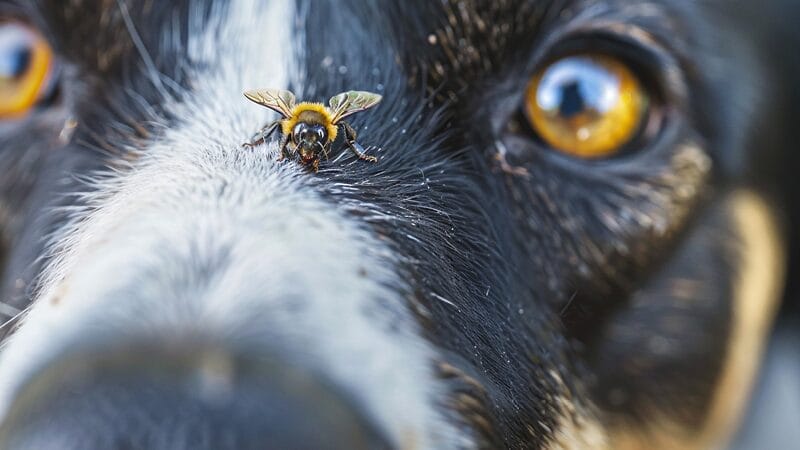
Battling Bugs: Common Insects That Irritate Pets in Warmer Weather
Warm weather means more outdoor time for pets, increasing their risk of bug bites and irritations. Learn about the signs and treatment.
As the temperatures rise, so does the activity of various insects, many of which can become a nuisance or even a danger to our pets. Understanding which bugs are likely to cause problems can help pet owners prevent discomfort and health issues. Here’s a comprehensive guide to the insects that commonly irritate pets during the warmer months, including where they are found, how they affect your pets, and what steps you can take to protect your companions.
Fleas
Fleas thrive in warm, humid environments and are commonly found in yards, parks, and anywhere animals congregate. They feed on blood, causing itching and discomfort. Their bites can lead to skin irritation, allergic reactions, and in severe cases, anemia (low red blood cells), particularly in cats.
Fleas and ticks can transmit hemotropic mycoplasma, an infection that destroys red blood cells and causes anemia. Additionally, fleas can also spread tapeworms to cats and dogs.
Check your pet’s skin and fur if you notice them excessively scratching, biting, or licking at the skin, or if you see their skin is red or irritated. You may also notice the presence of tiny dark specks (flea dirt) in your pet’s coat.
Contact your family veterinarian if you notice signs of an allergic reaction, persistent scratching leading to skin damage, or if your pet seems lethargic and pale (which could indicate anemia).
You can help prevent fleas from irritating your pets with the regular use of flea prevention treatments as recommended by your vet. Keeping your home and environment clean by vacuuming frequently and washing your pet’s bedding regularly is also helpful.
Ticks
Ticks are often located in wooded areas, tall grasses, and bushes. They are prevalent in many parts of the country, particularly where deer and other wildlife are common. Ticks attach to your pet’s skin to feed on blood and can transmit diseases such as Lyme disease, Rocky Mountain spotted fever, and ehrlichiosis.
Regularly check for ticks on your pet’s skin, especially around the neck, ears, head, and feet, particularly when they’ve spent time outdoors. Lyme disease can take up to 24-48 hours to infect the host, so it’s imperative to remove a tick found on your pet immediately.
To safely remove a tick from your dog:
- Use tweezers or a tick removal tool: It’s important to firmly grasp the tick by its head, close to the skin, and avoid squeezing the body. This helps prevent the tick’s contents, including potential disease-causing bacteria, from being forced into the skin.
- Pull gently and steadily: With a firm grip on the tick’s head, pull straight upward with a steady motion. Avoid twisting or jerking, as this may cause the tick’s mouth or head to break off and remain in the skin.
- Check for any remnants: After removing the tick, inspect the area to ensure that the entire tick, including its head and mouthparts, has been removed. If any parts remain, try to remove them using the same gentle technique. If you encounter difficulty, consult your veterinarian for assistance.
- Clean the area: Thoroughly clean the bite area with soap and water to reduce the risk of infection. You can also apply an antiseptic to the area if desired.
- Monitor for signs of infection: Keep an eye on the bite area for the next 24 hours. If you notice any redness, swelling, or signs of infection, contact your veterinarian for further guidance.
Watch this helpful video to see how to remove a tick from your dog. If you’re unsure about removing a tick or if your dog shows any signs of illness after a tick bite, it’s always best to consult with your veterinarian for proper guidance and care.

Mosquitoes
Mosquitoes are found near standing water, in gardens, and near wooded areas. They are more active during dusk and dawn. Mosquito bites can be itchy and irritating to pets. More seriously, mosquitoes are carriers of heartworm larvae, which can lead to heartworm disease.
Signs that your pet may have been bitten by mosquitoes include scratching at bite sites, red welts similar to those seen in humans, and signs of heartworm disease, which can include coughing, lethargy, and difficulty breathing. If you suspect your pet has heartworms, which can be fatal if untreated, contact your veterinarian.
To help keep these pesky insects from biting your pets (and yourself) consider mosquito repellent treatments that are safe for pets and keep your pet indoors during peak mosquito times. Ensure your pet is on a heartworm preventive medication as prescribed by your vet.
Bees and Wasps
Bees and wasps can be found anywhere flowers are present or where food is consumed outdoors. Their stings can cause pain, swelling, and in allergic pets, more severe reactions. Your pet may paw at their face or the bitten area, drool, and show agitation. If the stinger is visible, gently remove it with tweezers, apply a cold compress to reduce swelling, and monitor your pet closely for signs of an allergic reaction.
Contact your family veterinarian If your pet is stung multiple times or if the sting is inside the mouth or throat, which can be particularly dangerous. If your pet is having difficulty breathing, visit MedVet or your local emergency hospital.

Prevention and General Care from Irritating Insect Bites
Preventing insect irritations in pets is primarily about controlling the environment and using veterinarian-approved preventive medications. Regular grooming and bathing can also help remove any insects before they cause a problem. During peak insect seasons, consider keeping your pets indoors during early mornings and late evenings when many insects are most active.
Warmer weather brings the joy of more outdoor time with our pets but also increases their exposure to irritating insects. By staying informed and proactive, you can ensure that your pet enjoys a comfortable, healthy summer free from the distress and danger of bugs. Always consult with your veterinarian about the best preventive measures and treatments for your specific pet and enjoy the warm months with peace of mind.
FAQs
What bugs are irritating to pets?
How do I keep bugs from biting or stinging my pet?
How do I remove ticks from my pets?
Learn More
For ways to ensure your pet lives a happier, healthier life, visit our Pet Care Resources library.
Pet Care ResourcesContents
Learn More
For ways to ensure your pet lives a happier, healthier life, visit our Pet Care Resources library.
Pet Care Resources


